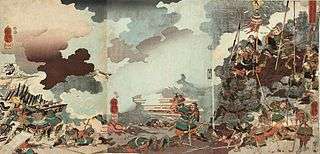Yamamoto Kansuke (general)
| Yamamoto Kansuke 山本勘助 | |
|---|---|
|
Yamamoto Kansuke fighting a giant boar, in a woodblock print by Utagawa Kuniyoshi. | |
| Born |
1501 Ushikubo, Mikawa Province, Japan |
| Died |
October 18, 1561 Shinano Province, Japan |
| Occupation | Strategist |


Yamamoto Kansuke (山本 勘助, 1501 – October 18, 1561) was a Japanese samurai of the Sengoku period. He was known as one of the "Twenty-Four Generals of Takeda Shingen".[1] Also known by his formal name, Haruyuki (晴幸).[2] He was a brilliant strategist, and is particularly known for his plan which led to victory in the fourth battle of Kawanakajima against Uesugi Kenshin. However, Kansuke never lived to see his plan succeed; thinking it to have failed, he charged headlong into the enemy ranks, dying in battle.
Biography
Kansuke's origins are not known for certain, but he is believed to have originated from Ushikubo, a town in Mikawa Province, which was then under the suzerainty of the Imagawa clan.[3] He came to Kai and began to serve Takeda Shingen in 1543, receiving a position as an infantry commander (ashigaru-taishō 足軽大将).[4] Legend says that Kansuke was blind in one eye and lame, but a fierce warrior and military strategist nevertheless.[5] In various works of art, he is depicted holding a naginata as a support for his weak leg. Kansuke was also involved in bringing the defeated Suwa Yorishige's daughter to Shingen as a concubine.[2]
He led the Pincer movement at the fourth Battle of Kawanakajima, but as he believed it to be a failure, he charged into the enemy ranks,[6] being killed in action with his two chief retainers, Osaragi Shōzaemon (大仏庄左衛門) and Isahaya Sagorō (諫早佐五郎).[7] Kansuke's adopted son Yamamoto Kanzō Nobutomo, was killed at the Battle of Kawanakajima.[2]
Kansuke was an ancestor of Yamamoto Yaeko of Aizu, a famed Bakumatsu period woman warrior.[8]
The Heihō Ōgisho (兵法奥義書), a treatise on strategy and tactics attributed to Kansuke, is included in the Takeda family chronicle, the Kōyō Gunkan.[9] In it, he focuses particularly on the strategic behavior of individual warriors.
In popular culture
For more information on Yamamoto Kansuke, see People of the Sengoku period in popular culture.
References
- ↑ Inoue, Yasushi. (2006). The Samurai banner of Furin Kazan, p. 7.
- 1 2 3 武田家臣団人事ファイル 山本晴幸(山本勘助)
- ↑ http://www.globetown.net/~hara_1962/SENGOKU/sengoku_12.html; http://f11.aaa.livedoor.jp/~chirori/takeda/ya/yamakan.php; http://www.zephyr.dti.ne.jp/~bushi/siseki/kansuke-tanjou.htm
- ↑ http://www.globetown.net/~hara_1962/SENGOKU/sengoku_12.html ; http://f11.aaa.livedoor.jp/~chirori/takeda/ya/yamakan.php
- ↑ Sato, Hiroaki (1995). Legends of the Samurai. Overlook Duckworth. p. 208-209. ISBN 9781590207307.
- ↑ Turnbull, Stephen (1998). The Samurai Sourcebook. Cassell & Co. p. 271. ISBN 1854095234.
- ↑ http://f11.aaa.livedoor.jp/~chirori/takeda/ya/yamakan.php Pronunciation for "Osaragi" as noted on this page
- ↑ Many notable Aizu families were descendants of Takeda retainer families. Even the daimyo, the Hoshina (Matsudaira) lord, was the descendant of one of Shingen's generals.
- ↑ 武家家伝_山本氏
Further reading
- Turnbull, Stephen (1998). 'The Samurai Sourcebook'. London: Cassell & Co.
- Emiya Takayuki 江宮隆之 (2006). Yamamoto Kansuke to wa nanimono ka: Shingen ni chōyō sareta riyū 山本勘助とは何者か: 信玄に重用された理由. Tokyo: Shōdensha 祥伝社.
- Ueno Haruo 上野晴朗 (1985). Yamamoto Kansuke 山本勘助. Tokyo: Shin Jinbutsu Ōraisha 新人物往来社.
- Watanabe Katsumasa 渡辺勝正 (1988). Takeda gunshi Yamamoto Kansuke no nazo 武田軍師山本勘介の謎. Tokyo: Shin Jinbutsu Ōraisha 新人物往来社.
External links
| Wikimedia Commons has media related to Yamamoto Kansuke (general). |
- "Legendary Takeda's 24 Generals" at Yamanashi-kankou.jp
- Yamamoto Kansuke at Samurai-Archives.com
- yamamotokansuke.com
